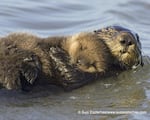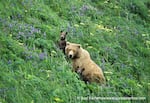
A one-month-old sea otter lies on its mother's belly in Monterey Bay, California.
Suzi Eszterhas
What could be cuter than a baby sea otter floating on its mother's belly? Or a baby orangutan dangling from its mother's hair?
In her new series of children's books, entitled "Eye On The Wild", photographer Suzi Eszterhas zooms in on adorable baby cheetahs, gorillas, orangutans and sea otters.
Suzi Eszterhas
But these aren't just cute, furry baby animals like you might see at the zoo. They're completely wild, and they're also endangered.
By focusing on wild baby animals growing up, Eszterhas says, she has a unique angle on the challenges faced by endangered species as they learn to hunt their prey and avoid predators. In each of her latest books, there's a line at the end that reminds young readers (the books are written for children ages 4-7) why they should worry about these little babies.
"Sea otters are endangered because people used to hunt them for their fur and people are now destroying their ocean home," reads the last line of one book.
"Cheetahs ... are endangered because people are destroying the grassy areas they live in and poaching the animals they hunt," says another.
Eszterhas has traveled all over the world to capture images of baby animals growing up. Finding them and getting close enough to photograph them can take a lot of work, she says.
A baby cheetah and its mother in Kenya's Maasai Mara Reserve.
To photograph cheetahs, for example, she spent almost two years living in a bush camp in Kenya and following three or four different cheetah families every day from sunrise to sunset.
To find a baby to photograph, Eszterhas sometimes has to be on call while a female is pregnant and being ready to start working when the baby is born. Then, she has to find a way to get close to the family without stressing out the animals.
"I do spend quite a lot of time sometimes breaking them in," she says.
"Every day I get a little bit closer to them and get them slowly used to my presence, so that eventually I can get close enough to take photographs and they’re comfortable with me and don’t get stressed. It’s a delicate thing gaining an animal’s trust, particularly when an animals that has newborns."
A 10-month-old mountain gorilla in Rwanda.
One animal Eszterhas says is especially fun to photograph is the gorilla.
“I could never, ever get sick of working with gorillas," she says. "They’re so similar to us in many of their behaviors in what they do. There's so much social interaction that photographing them is always stimulating and always exciting.”
And the species she worries about most is probably the organgutan because its habitat is increasingly threatened by palm oil plantations – particularly on the Indonesian island of Sumatra.
A baby and mother orangutan in Sumatra.
"Orangutans are critically, critically endangered, and I worry about them all the time," says Eszterhas.
"There are active rescues taking place on the ground almost every day getting orangutans out of areas where they’re surrounded by palm and they have nothing to eat and they’re starving to death. Or worse, getting shot by palm oil plantation workers and the babies wind up on black market as pets."
Tonight's event in Portland, part of the Science Pub series organized by the Oregon Museum of Science and Industry, will start at 7 pm at 4122 NE Sandy Blvd.
-- Cassandra Profita


